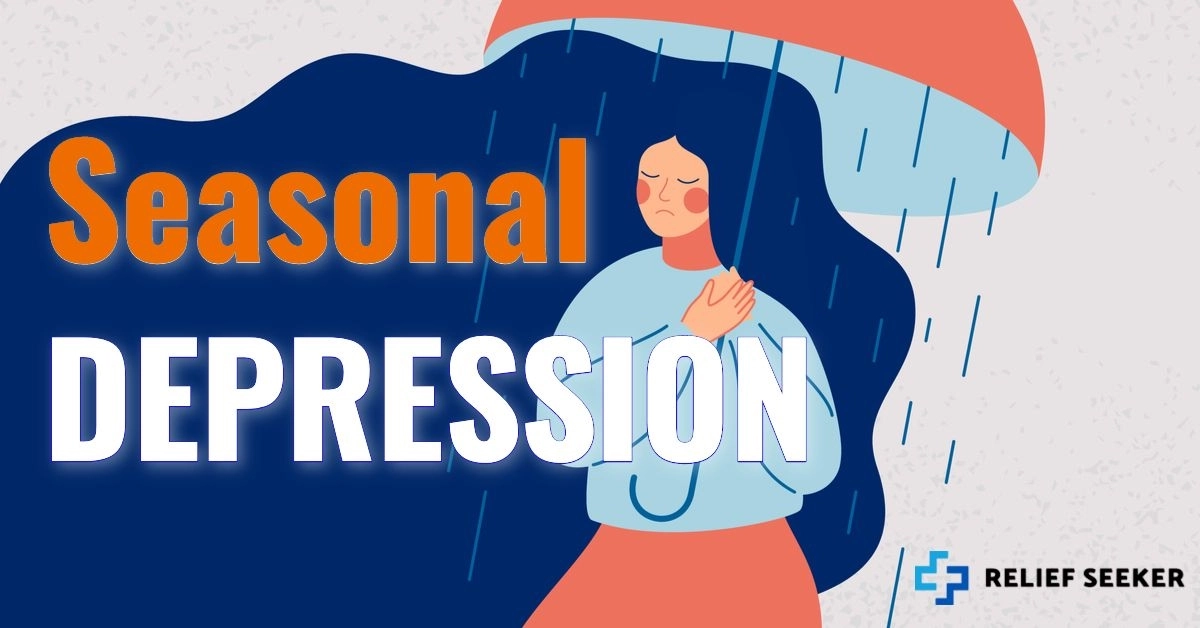Seasonal depression is known by many names, including seasonal affective disorder or SAD (its clinical name), seasonal blues, or winter depression. Millions of people in the U.S. alone suffer from this disorder (about 5% of Americans); yet, it often goes untreated simply because people don’t know they have it.
Seasonal depression usually starts in the autumn, though this may vary from person to person. Depending on your gender, geographic location, history of mental illness, and genetics, you may experience SAD as early as August and as late as May the following year.
Find out if you are at risk for seasonal depression and how to treat it if you’re already experiencing symptoms.
Who Is at Risk for Seasonal Depression?
Some people have a higher risk of developing seasonal depression. Some of the main factors that can result in a higher risk of seasonal depression include:
Gender
Location
Age
Genetics
History of mental illness
Gender
Women are more susceptible to seasonal depression than men. Unfortunately, researchers aren’t totally clear on why this is, but some scientists believe that hormonal fluctuations may be to blame. Estrogen fluctuations, in particular, can affect the production of serotonin (the feel-good chemical that produces spikes of happiness in the brain and in the gut).
Location
According to the National Institute of Mental Health (NIMH), the further north you live (or the further you live from the equator), the more likely you are to develop seasonal depression. Essentially, the less sunlight you see each day, the more likely you are to develop this condition.
This is why people that live in Alaska and Maine are more likely to suffer from SAD than people in Florida or Texas. In fact, people that live in the Arctic Circle are more likely to commit suicide because of this condition.
If you’re considering hurting yourself or others (or if someone you know is), call 911 or call the National Suicide Prevention Lifeline at 800-273-8255.
Age
Seasonal depression generally rears its head earlier in life. Most people report experiencing seasonal affective disorder earlier in life (as early a young adulthood).
Genetics
Your genetics can play a major role in seasonal depression. If you are related to someone that suffers from this condition or if seasonal depression runs in your family, you’re more likely to suffer from it yourself.
If your family members suffer from other types of mental illnesses (such as depression, bipolar disorder, and schizophrenia) you’re also more likely to suffer from SAD as well.
History of Depression
If you have a history of mental health disorders (specifically, depression and bipolar disorder), you’re more likely to develop seasonal depression, too.
Seasons Affective Disorder and COVID-19
COVID-19 may play a major role in seasonal affective disorder, too. One of the main causes of this condition is reduced social activity (and subsequent further social withdrawal).
Researchers believe that social distancing has already caused an uptick in depression and suicide rates all over the world. As Americans retreat into their homes for the winter (and isolate themselves away from friends and family even further), depression rates are expected to rise.
Combine seasonal depression with situational depression, bipolar disorder, and coronavirus isolation? It’s no surprise scientists believe the number of cases of SAD will spike during the pandemic.
Causes of Seasonal Depression
There are several causes of seasonal depression. The main cause of seasonal depression is a disruption of the body’s circadian rhythm from late fall to early spring — thanks to the shorter hours of sunlight each day.
If you suffer from this type of depression, your condition may be caused by one or more of the below common factors:
Fewer daylight hours
Genetic factors
Hormonal imbalances
Melatonin influx
Seasonal situational depression
Serotonin deficiency
Vitamin D deficiency
Seasonal Depression Symptoms
The symptoms of seasonal depression vary from person to person. If you suffer from depression, bipolar disorder, or other mental illnesses, your seasonal depression may be tied to these conditions.
Many of the symptoms of seasonal depression are the same as those of major depression. When diagnosing seasonal depression, your doctor will try to determine if you have symptoms of major depression — in addition to seasonal symptoms. According to the NIMH, to be diagnosed with seasonal depression, you must also display symptoms of major depression, including:
Changes in appetite
Changes in weight
Difficulty concentrating
Feeling hopelessness/worthlessness
Feelings of agitation or irritation
Feelings of depression (most of the day/every day)
Loss of interest in activities you used to enjoy
Low energy
Sleeping to much
Thoughts of death or suicide
In addition to the above symptoms of depression, you may also exhibit symptoms of seasonal depression, including:
Craving carbohydrates
Overeating
Sleeping too much
Social withdrawal
Weight gain
For patients to be diagnosed with seasonal depression, they must show symptoms of major depression, a seasonal pattern, or seasonal depression during specific seasons for two or more consecutive years.
Despite the requirements for diagnosis, not all people suffering from SAD experience symptoms in consecutive years. Yet, seasonal depression is generally marked by depressive episodes that happen in one particular season.
Some patients suffer from seasonal spring and summer depression, too. Yet, these patients often don’t exhibit the same depressive symptoms in the winter months.
If you suffer from depression year-round, your symptoms may not be diagnosed as seasonal depression; yet, they may indicate another type of depressive disorder. Since diagnosing these conditions is so specialized, most doctors don’t recommend self-diagnosis.
Preventing Seasonal Depression
There isn’t much research suggesting seasonal depression can be prevented. Yet, there are plenty of studies that suggest that some lifestyle factors are more likely to lead to major depressive disorder and/or worsen situational depression. Some of these lifestyle choices may include:
Diet
Exercise
Stimulant Use
Sleep
Diet
Eating foods that support your hormones (like fresh fruits, veggies, and proteins) can help your body produce serotonin.
Exercise
Getting at least 30 minutes of exercise each day can also help boost happiness-producing hormones (like serotonin and dopamine). It can also decrease anxiety-inducing hormones, like cortisol.
Stimulants
It’s easy to want to increase stimulant use during the winter months. Drinking a cup of coffee seems like a no-brainer when it comes to keeping our eyelids open when the days get shorter.
But caffeine can actually throw our hormones off course even further. So can stimulants such as sugar, nicotine, and alcohol.
Sleep
Getting plenty of shut-eye may seem easy when the days are so short! Yet, it’s important to keep a consistent sleep schedule — meaning going to bed at the same time you would when the days are shorter.
SAD Treatment
The NIMH recommends talking with your doctor or mental health professional if you’re experiencing seasonal depression. Yet, most doctors recommend the following treatments for seasonal depression:
Light therapy
Talk therapy
Support groups
Antidepressants
Vitamin D
Light Therapy
Light therapy is one of the most common treatments for SAD. This type of therapy utilizes a bright light that mimics sunlight. Simply sit in the rays of a light therapy lamp for a prescribed amount of time (usually between 20 and 30 minutes), and let the lamp work its magic.
Most experts recommend using a lamp or lightbox first thing in the morning when you wake up. If your depression symptoms are extreme, you may need to use the sun lamp for up to one hour per day.
Talk Therapy
Doctors usually recommend patients use a combination of different therapies on this list. Light therapy, vitamin D, and antidepressants are all usually prescribed alongside talk therapy.
Talk therapy can help you work out your depression on a cognitive level. Talking to a therapist can help you manage anxiety, depression, and stress. Cognitive-behavioral therapy is also a great way to handle situational seasonal depression (such as holiday stress, pandemic anxiety, and cabin fever).
Online talk therapy platforms like Talkspace can match you with a therapist that specializes in seasonal depression. You can connect with your therapist via video chat or text message.
Antidepressant Medications
Since seasonal depression is often caused by an imbalance in brain chemicals (specifically, serotonin), it’s commonly treated with antidepressants, such as selective serotonin reuptake inhibitors (SSRIs).
To be prescribed medications for a mood disorder, you’ll need to make an appointment with a doctor of psychiatry (different from a psychologist).
You can visit your general care practitioner, make an appointment with an in-person psychiatrist, or make an appointment with an online psychiatrist with platforms like Talkspace Psychiatry.
Consultations usually take around 45 minutes; you can make follow-up appointments if you need your medication levels tweaked.
Vitamin D
One of the causes of seasonal depression is a lack of vitamin D. If you live in an area of the world that doesn’t get high levels of sun exposure (such as the Pacific Northwest), you may have a vitamin D deficiency.
Want to know if you have a deficiency? Order an at-home test kit to see which nutrients you may need to supplement.
Support Groups
Sometimes you just need a little extra support when it comes to seasonal depression. Online support groups like Wisdo can match you with users that have ‘been through’ seasonal depression and can offer advice and support.
These groups meet virtually, so you don’t need to leave your home to get support for your SAD!


